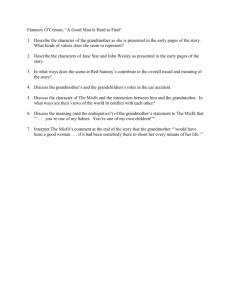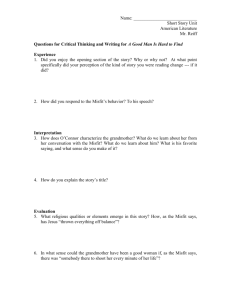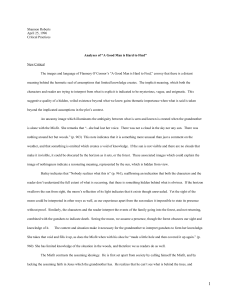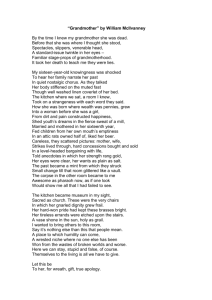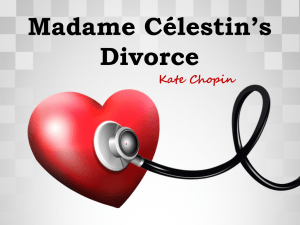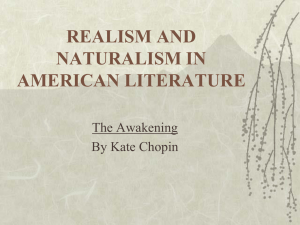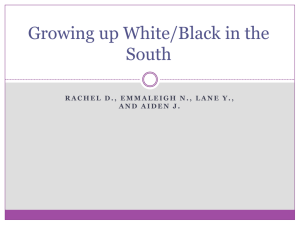A Good Man is Hard to Find
advertisement
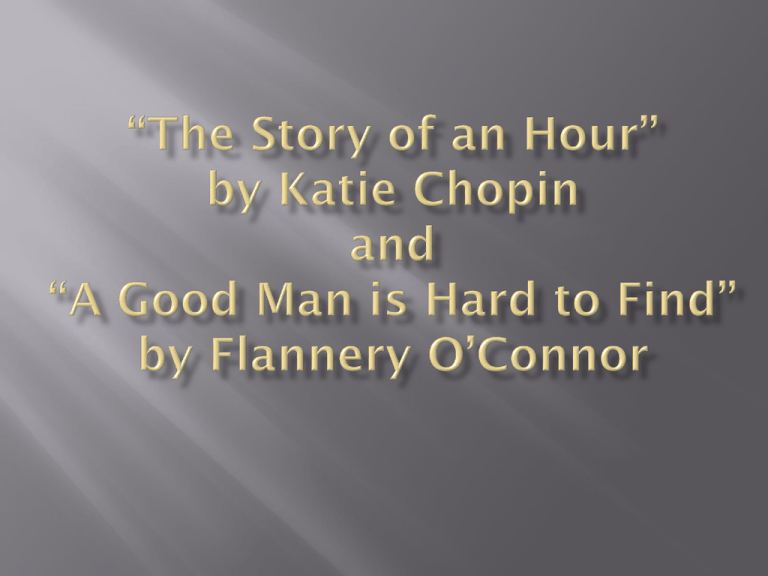
1. In the last sentence of the story, the attending doctors pronounce the cause of Mrs. Mallard's death to be "the joy that kills." What do the doctors mean by this? a. She is overcome by despair because she realizes she is still married. b. She is overwhelmingly happy that Brently is alive. c. She is deathly frightened that Brently will become violent when he discovers her relationship with Richards-and the doctors cover it up. d. She dies in the throes of passion when Brently returns alive; unfortunately, she is too physically weak for love. 2. According to Josephine's account, how did Mr. Mallard die? a. He was killed in the war. b. He died of heart disease. c. He was in a train wreck. d. He was mauled by large dogs. 3. "[Mrs. Mallard] sat with her head thrown back upon the cushion of the chair, quite motionless, except when a sob came up into her throat and shook her, as a child who has cried itself to sleep continues to sob in its dreams." Which of the following is the most appropriate paraphrase of the simile in this passage? a. Like a child sobbing uncontrollably, Louise is not in control of her emotions. b. Like an overwhelmed child, Louise needs to be attended to by her sister and Richards. c. As children are frightened by dreams, so Louise is terrorized by her marriage. d. As a child will sob after losing consciousness, Louise did not know anymore why she was crying. 4. Which of the following best describes June Star's and John Wesley's behavior toward adults? a. disrespectful b. submissive c. frightened d. cheerful 5. The grandmother suggests a detour to see what sight? a. a Civil War battleground b. an old plantation house she had visited in her youth c. a statue of Robert E. Lee d. a craft fair 6. What causes the family's car accident? a. The grandmother's cat startles Bailey as he is driving. b. The children's fight over the comic book distracts Bailey as he is driving. c. The baby's shrieking distracts the mother as she is driving. d. The Misfit runs them off the road. 7. What does the grandmother say that causes the Misfit to kill her? a. She tells him Jesus has saved him. b. She begs him to spare her grandchildren and kill her instead. c. She calls him one of her own children. d. She tells him he cannot be saved. Katherine O’Flaherty was born in St. Louis, Missouri, to a Creole-Irish family that enjoyed a high place in society. Her father died when she was four, and Kate was raised by her mother, grandmother, and great-grandmother. Very well read at a young age, she received her formal education at the St. Louis Academy of the Sacred Heart. In 1870, she married Oscar Chopin, a Louisiana businessman, and lived with him in Natchitoches parish and New Orleans, where she became a close observer of Creole and Cajun life. Following her husband’s sudden death in 1884, she returned to St. Louis, where she raised her six children and began her literary career. In slightly more than a decade she produced a substantial body of work, including the story collections Bayou Folk (1894) and A Night in Acadie (1897) and the classic novella The Awakening (1899), which was greeted with a storm of criticism for its frank treatment of female sexuality. Kate Chopin’s biography may illuminate some of the central themes and issues in play in “The Story of an Hour.” Chopin married her husband, Oscar Chopin, in 1870 when she was twenty years old. The couple moved to New Orleans, where he pursued a career as a cotton broker and she became active in the city’s social life. Kate Chopin attracted attention in the city for her unconventional insistence on her own freedoms: she smoked and drank, and sometimes went out unattended in the evenings. By all accounts, her husband was tolerant, and perhaps even encouraging, of her independence, and their marriage seemed to be one of mutual respect and affection. When Oscar Chopin’s cotton brokerage failed in 1879, he moved his family—which by this time included six children—to rural Louisiana, where he managed some small plantations and a general store. In 1883, he died of swamp fever, leaving Kate a thirty-two-year -old widow with six children to support and limited financial resources. Chopin soon relocated to St. Louis, where she moved into her mother’s house and began writing poetry and short stories. By 1894, she had established a national reputation as a writer of “local color” fiction that captured the distinctive customs and culture of Louisiana. Her career is also notable for her creation of unconventional female heroines and her willingness to engage controversial subjects like female sexuality, divorce, and miscegenation. Eventually, her work provoked hostile reviews, and she encountered difficulty publishing and selling her more daring stories. What is the significance of Mrs. Mallard’s diagnosis of “heart trouble”? What symbolic significance might this phrase contain? When do we learn the main character’s first name? What is the effect of revealing this information late in the story? How would you describe the narrative point of view in “The Story of an Hour”? Does it change or shift over the course of the story? How does our varying access to Mrs. Mallard’s thoughts and feelings affect our understanding of events and of her character? Why do you think Chopin chose the “short story” form for this story? What is left out or underdeveloped in the 1,000-word format? What is enhanced by the concentrated narrative? Examine the final line of the story. Is the doctors’ diagnosis of “a joy that kills” an example of irony? How does irony work in this sentence? Mary Flannery O’Connor was born in Savannah, Georgia, studied at the Georgia State College for Women, and won a fellowship to the Writer’s Workshop of the University of Iowa, from which she received her MFA. In 1950, she was first diagnosed with lupus, a painful autoimmune disorder that had killed her father and would trouble her for the rest of her brief life. Her first novel, Wise Blood, was published in 1952, and her first collection of stories, A Good Man Is Hard to Find, in 1955. She was able to complete only one more novel, The Violent Bear It Away (1960), and a second collection of stories, Everything That Rises Must Converge (1965), before dying of lupus in Milledgeville, Georgia. Her posthumously published Complete Stories won the National Book Award in 1972. A collection of letters, edited by Sally Fitzgerald under the title The Habit of Being, appeared in 1979. Southern gothic has been described as literature focused on “disturbed people doing disturbing things.” As a genre or a topical focus of some southern writing, southern gothic is characterized by its casts of strange characters, its interest in bizarre or macabre occurrences, and the way it uses these “grotesqueries” to explore social issues unique to the American South. Narratives in the southern gothic tradition tend to examine social and behavioral codes by depicting people who are engaged in acts ranging from the out of the ordinary to the eccentric to the taboo. Incest, murder, suicide, lynching, rape, castration, and insanity are not unusual topics within southern gothic literature. O’Connor’s fiction was deeply influenced by her Roman Catholic faith, and by her commitment to revealing what she thought of as “the central Christian mysteries,” or moments of awakening, grace, and redemption. As you read O’Connor’s fiction, you may find it difficult always to locate or understand the Christian principles at work in what often seem like macabre and violent stories, peopled by characters profoundly lacking in sympathy and selfawareness. O’Connor explained that she found “violence strangely capable of returning my characters to reality and preparing them to accept their moment of grace.” On the other hand, she also acknowledged that “there are, perhaps, other ways than my own in which [my stories] could be read.” Audio version of text, read by Flannery O’Connor What values or worldview does the grandmother represent in “A Good Man Is Hard to Find”? How, specifically, do her own words and those of the narrator contribute to our understanding of her character? What stance does the story encourage us to take in regard to the grandmother? The grandmother is associated with the past from the beginning of “A Good Man.” What was the past like, according to the grandmother and Red Sammy? How was it different from, and better than, the present? During their brief encounter, both the Misfit and the grandmother talk about religion and morality. What does the story ultimately say about either or both of these issues? To what extent and how, specifically, might “A Good Man” embody O’Connor’s belief, expressed in “The Fiction Writer and His Country,” that “the meaning of life is centered in our Redemption by Christ”? that, as O’Connor says in “The Grotesque in Southern Fiction,” “life is and will remain essentially mysterious”? From its title right through to the Misfit’s comments about the dead grandmother, this story clearly explores the question of what it means to be a “good” man or woman, contrasting at least two different definitions of “good.” What are those definitions? What, if any, definition, does the story ultimately embrace?
